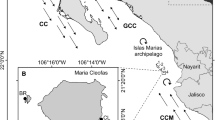Abstract
A coral settlement device was used to examine recruitment patterns of Acropora at two stations (st.; A and B) in Bunaken Island, Manado. The recruitment timing of Acropora was not determined because of mixing with Isopora. A marine block (MB) was used to observe the growth of settled acroporid corals at st. A. Within a year of settlement (February–May of the following year), the corals which had settled on the MB had grown to a size of 13.4 ± 5.86 mm. They were dominated by Isopora, with a small proportion of Acropora. A supplementary experiment again using the MB was conducted at three other sites (st. C, D, E) where Isopora was not abundant. The size of the corals which settled on the MB was nearly the same as that of the corals at st. A. Juvenile Acropora corals (≤3 cm, encrusting form) were measured on the Manado coast (st. F) between February and May. At this site, Acropora corals were dominant and no Isopora corals were observed; the size of Acropora was 18.5 ± 5.01 mm. Acroporid corals in February and March at st. A appeared smaller than those at st. F and grew to nearly the same size in early April.






Similar content being viewed by others
References
Hughes T (1994) Catastrophes, phase shifts, and large-scale degradation of a Caribbean coral reef. Science 265:1547–1551
Hoegh-Guldberg O (1999) Climate change, coral bleaching and the future of the world’s coral reefs. Mar Freshw Res 50:839–866
Jackson JBC, Kirby MX, Berger WH, Bjorndal KA, Botsford LW, Bourque BJ, Bradbury RH, Cooke R, Erlandson J, Estes JA, Hughes TP, Kidwell S, Lange CB, Lenihan HS, Pandolfi JM, Peterson CH, Steneck RS, Tegner MJ, Warner RR (2001) Historical overfishing and the recent collapse of coastal ecosystems. Science 293:629–638
Carpenter KE, Abrar M, Aeby G, Aronson RB, Banks S, Bruckner A, Chiriboga A, Cortes J, Delbeck JC, DeVantier L, Edgar GJ, Edwards AJ, Fenner D, Guzman HM, Hoeksema BW, Hudgson G, Johan O, Licuanan WY, Livingstone SR, Lovell ER, Moore JA, Obura DO, Ochavillo D, Polidoro BA, Precht WF, Quibilan MC, Reboton C, Richards ZT, Rogers AD, Sanciangco J, Sheppard A, Sheppard C, Smith J, Stuart S, Turac E, Veron JEN, Wallace C, Weil E, Wood E (2008) One-third of reef-building corals face elevated extinction risk from climate change and local impact. Science 321:560–563
Fitt WK, Brown BE, Warner ME, Dunne RP (2001) Coral bleaching: interpretation of thermal tolerance limits and thermal thresholds in tropical corals. Coral Reefs 20:51–65
Franklin DJ, Hoegh-Guldberg O, Jones RJ, Berges JA (2004) Cell death and degeneration in the symbiotic dinoflagellates of the coral Stylophora pistillata during bleaching. Mar Ecol Prog Ser 272:117–130
Renema W, Bellwood DR, Braga L, Bromfield K, Hall R, Jonason KG, Lunt P, Meyer CP, McMonagle LB, Morley RJ, O’Dea A, Todd JA, Wesselingh FP, Wilson ME, Pandolfi JM (2008) Hopping hotspot: global shifts in marine biodiversity. Science 321:654–657
Barber PH (2009) The challenge of understanding the coral triangle biodiversity hotspot. J Biogeogr 36:1845–1846
Roeroe AK, Yap M, Okamoto M (2009) Development of a coastal environment assessment system using coral recruitment. Fish Sci 75:214–224
Okamoto M, Nojima S, Fujiwara S, Furushima Y (2008) Development of ceramic settlement devices for coral reef restoration using in situ sexual reproduction of corals. Fish Sci 74:1245–1253
Isoo T, Takahshi T, Fukhara M (2001) Using carbonated steelmaking slag blocks to help reduce CO2. J Am Ceram Soc Bull 80(1):73–75
Okamoto M, Yap M, Roeroe KA, Nojima S, Oyamada K, Fujiwara S, Iwata I (2010) In situ growth and mortality of juvenile Acropora over two years following mass spawning in Sekisei Lagoon, Okinawa (24°N). Fish Sci 76:343–353
Kojis BL, Quinn NJ (1984) Spacial and depth variation in fecundity of Acropora palifera at two reefs in Papua New Guinea. Coral Reefs 3:165–172
Kojis BL (1986) Sexual reproduction in Acropora (Isopora) sspecies (Coelenterata: Scleractinia), I. A. cuneata and A. palifera on Helon Island reef, Great Barrier Reef. Mar Biol 91:291–309
Kojis BL (1986) Sexual reproduction in Acropora (Isopora) (Coelenterata: Scleractinia), II. Latitudinal variation in A. Palifera from the Great Barrier Reef and Papua New Guinea. Mar Biol 91:311–318
Veron JEN (2000) Corals of the world, vol 1. Australian Institute of Marine Science, Cape Cleveland
Wallace CC, Chen CA, Fukami H, Muir PR (2007) Recognition of species genera within Acropora based on new morphological, reproductive and genetic evidence from Acropora togianensis, and elevation of the subgenus Isopora studer, 1878 to genus (Scleractinia: Astrocoeniidae; Acroporidae). Coral Reefs 26:231–239
Guest JR, Baird AH, Gou BPL, Chou LM (2005) Reproductive seasonality in an equatorial assemblage of scleractinian corals. Coral Reefs 24:112–116
Penland L, Kloulechad J, Idip D, Van Woesik R (2004) Coral spawning in the western Pacific Ocean is related to solar insulation: evidence of multiple spawning events in Palau. Coral Reefs 23:133–140
Romantzki SBC (2008) Reproduction strategies of stony corals (Scleractinia) in an equatorial, Indonesian coral reef. Contribute for the reef-restoration. PhD thesis. Bremen University, Bremen
Mangubhai S, Harrison PL (2008) Asynchronous coral spawning patterns on equatorial reefs in Kenya. Mar Ecol Prog Ser 360:85–96
Acknowledgments
We thank the Ministry of Research and Technology of Indonesia, DGHE of Ministry of Education and Culture Indonesia, the Bunaken Marine National Park Authority, the Regional Development Planning Board, and the Marine Affairs and Fisheries Agency, Government of North Sulawesi for their collaboration in this study. We are grateful to Mr Atsunobu Sugita, Forestry Agency (former Master student of Tokyo University of Marine Science and Technology) for analyzing the CSDs. This study was funded by a Grant-in-Aid for Science Research (nos. 16211017 and 20241018) and a grant of the Steel Foundation for Environmental Protection Technology.
Author information
Authors and Affiliations
Corresponding author
Rights and permissions
About this article
Cite this article
Yap, M., Roeroe, K.A., Lalamentik, L.T.X. et al. Recruitment patterns and early growth of acroporid corals in Manado, Indonesia. Fish Sci 79, 385–395 (2013). https://doi.org/10.1007/s12562-013-0606-9
Received:
Accepted:
Published:
Issue Date:
DOI: https://doi.org/10.1007/s12562-013-0606-9




